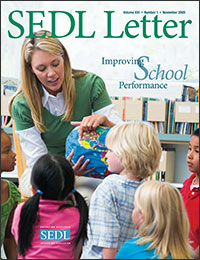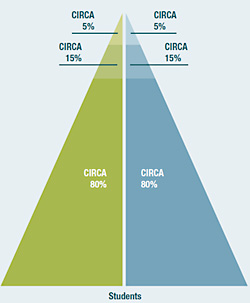Uncharted Territory: Using Tiered Intervention to Improve High School Performance
| Academic Systems Tier 3
Tier 2
Tier 1
| Figure 1:
| Behavioral Systems Tier 3
Tier 2
Tier 1
|
| Source: Batsche, G., Elliott, J., Graden, J. L., Grimes, J., Kovaleski, J. F., Prasse, D., Reschly, D. J., Schrag, J., and Tilly, W. D. (2006). Response to Intervention: Policy considerations and implementation (p. 22). Alexandria, VA: National Association of State Directors of Special Education, Inc. Reprinted with permission from NASDSE (www.nasdse.org). | ||
RtI is used at the elementary level, and as the evidence of its effectiveness at that level increases and the research base expands, high school leaders also seek to use RtI to increase student success. Implementing RtI at the high school level, however, is not a matter of simply replicating what has taken place in elementary and middle schools. High school leaders who adopt RtI encounter new challenges and must discover new ways to use its framework. This article provides an overview of how educators might implement the RtI components at the high school level, identifies some challenges unique to the secondary setting, and outlines potential solutions to some of those challenges.
What Is RtI?
RtI is the professional practice of providing research-based academic and behavioral instruction and intervention in multiple tiers of increasing frequency and intensity. Tier 1 is instruction in the core curriculum/program based on a state’s content standards. Students who receive Tier 1 instruction but do not meet set learning objectives or standards receive targeted, small-group supplemental interventions (Tier 2) in addition to core instruction. In Tier 3, intensive, one-on-one interventions are implemented for students who do not reach proficiency levels in Tier 2. Students who undergo multiple tiers of intervention but still show little or no mastery as measured by progress monitoring may be referred for special education testing. Although different ways of implementing RtI exist, the framework typically has some essential components: high-quality research-based instruction, universal screening, research-based interventions of increasing levels of intensity (tiers 1, 2, and 3), progress monitoring, and the use of data to make instructional decisions.
RtI is the professional practice of providing research-based academic and behavioral instruction and intervention in multiple tiers of increasing frequency and intensity.
RtI can be implemented by using two approaches: the problem-solving method or the standard treatment protocol. The problem-solving method is a decision-making system in which teacher teams work collaboratively to define the academic and/or behavioral challenges experienced by a student; analyze why the student is experiencing difficulties; develop a specific plan to address the weaknesses; and evaluate the effectiveness of the intervention plan (Batsche et al., 2005). This process can occur at all tiers of instruction or intervention.
In the standard treatment protocol, a single standard intervention is chosen, and the prescribed intervention protocol is implemented for all students in a grade level who score below benchmark standards set by the school or district (Hall, 2008). Schools may choose to implement either one or a combination of the two methods.
RtI gained national attention in education policy in the late 1990s as an alternate way of identifying students with learning disabilities. With the reauthorization of the Individuals with Disabilities Act (IDEA) in 2004, states were given the option to use RtI to make determinations of specific learning disabilities; however, schools have not limited RtI to this use. With greater focus on academic rigor, student achievement, and school and teacher accountability, many states have adopted and are implementing RtI fully in general education settings, primarily in elementary schools.
A growing research base supports these efforts. In 2009, the What Works Clearinghouse—an initiative of the U.S. Department of Education’s Institute of Education Sciences that assesses the rigor of research evidence on the effectiveness of interventions and produces research-based practice guides for educators—released two practice guides on RtI. One offers recommendations for using RtI to help students struggling with literacy in the primary grades (K–2) (Gersten, Compton, et al., 2009); and the second, to help elementary and middle school students (K–8) struggling with mathematics (Gersten, Beckmann, et al., 2009).
RtI at the High School Level
Like many innovations and reform efforts to improve student outcomes, RtI initiatives have focused largely on elementary schools, due in part to preexisting infrastructure and RtI-like practices created through the implementation of programs such as Reading First. The encouraging results of the impact of RtI on students’ reading skills in early grades (Gersten, Compton, et al., 2009) led districts and schools to explore the possibility of expanding RtI initiatives to high schools.While much is still unknown about the RtI process in high schools, some districts across the country are implementing the practice in their high schools and are sharing anecdotal reports of positive impacts on learning and student gains. Measures of RtI outcomes have included increases in the number of students who transition from remedial to mainstream or even AP classes, pass the state assessment, and graduate from high school. These reports also cite declines in dropout rates, behavior referrals, and the number of students referred to special education (Barton, 2008; Burns, 2008; Duffy, 2007).
Currently, there are no randomized controlled trials on the implementation of the RtI process in high schools. Nevertheless, some research findings and evidence provide guidelines for using RtI for literacy (Torgesen et al., 2007; Kamil et al., 2008) and mathematics instruction (Jayanthi, Gersten, & Baker, 2008), as well as proven instructional strategies (Pashler et al., 2007) for secondary students.
How Do the Key Components of RtI Relate to High School?
The ways in which RtI components are operationalized in high schools depend on the context of the school, which is vastly different from that of elementary and middle schools. Although RtI can be designed to fit the philosophy, personnel, experience, needs, structure, and organization of a given school or district, some core elements are essential to an RtI framework (Canter, Klotz, & Cowan, 2008).
RtI Resources
| Additional information about resources for implementing RtI in high schools can be found on SEDL’s Web site: www.sedl.org/hsrti/
|
Universal Screening
An important premise of RtI is that educators should identify and help struggling students early—before they fail (The Center for Comprehensive School Reform and Improvement, 2008). Without universal screening, students who perform poorly in elementary and middle school may not be identified for additional supports until high school (Duffy, 2007). To implement universal screening, schools must screen their students in essential areas for academic and behavioral difficulties early in the school year. Based on students’ performance on these screening measures, teachers select research-based core instructional programs and provide instruction/intervention to whole groups of students in the general education classroom. This is Tier 1 instruction.During high school, student learning is focused on highly specialized subject matter content, and key to screening is the use of multiple sources of data to improve student learning (Bernhardt, 2006). A combination of indicators can be screened and tracked. Screening in the following domains can provide useful data to educators for identifying students who need additional support: report card grades, grade-level common formative assessments, benchmark assessments, state assessments, end-of-course exams, behavior and disciplinary referrals, retention rates, attendance (especially for ninth-grade students), risk of dropout, and risk of not graduating.
Because of their departmental structure and schedule constraints, high schools can screen students at the grade level, department-wide, or schoolwide. Kurns and Tilly (2008) have outlined basic steps to universal screening for all grade levels:
- Identify content area(s) and skills to be screened (e.g., reading comprehension, algebra).
- Identify screening measures.
- Set proficiency cut-points to identify students with differing levels of risk or need.
- Determine frequency of screening (e.g., once, twice, or three times per year).
- Identify teachers to conduct screening.
- Collect universal screening data.
- Decide what to do with the data (enter, organize, summarize, and display data).
- Respond to results.
High-Quality Research-Based Instruction
Tier 1 (core curriculum) instruction takes place in the general education classroom and is the foundation upon which all supplemental and individualized interventions are designed for students who are struggling with content areas. Kurns and Tilly (2008) note that to implement RtI, principals and teachers must define what constitutes universal Tier 1 curriculum and instruction and take steps to determine if the core program is sufficiently meeting the needs of the majority (80% or more)of students.
Tier 1 instruction might include some of the following components:
- Research-based programs and strategies in content areas
- Core curriculum that is aligned to state content standards
- Differentiated instructional strategies to meet the unique needs of learners
- Sound instructional techniques across content areas
- Curriculum aligned with the demands of post-secondary settings, such as higher education and the workforce
- Positive behavioral supports
- Lessons on study skills, organizational skills, and motivational strategies
- Content that reflects the needs of culturally and linguistically diverse learners
- Electives that help underrepresented groups (e.g., students from low-income families) gain admittance to 4-year colleges and universities
 procedures (Sandomierski, Kincaid, & Algozzine, 2007).
procedures (Sandomierski, Kincaid, & Algozzine, 2007). In addition to screening data, high school students’ developmental, emotional, and social needs and academic and cognitive abilities, coupled with the unique demands of particular settings, should be considered when selecting core instructional approaches or designing instructional strategies (Ehren, 2009). Universal instructional design principles such as direct instruction, teacher modeling, scaffolded instruction, metacognitive instruction, and engagement approaches proven to be sound are important parts of core instructional techniques (Deshler & Kovaleski, 2007).
Research-Based Interventions
After outlining core instruction, the next step is to identify students for whom the core instruction is insufficient, determine why (Kurns & Tilly, 2008), and then delineate Tier 2 and Tier 3 interventions for those students. Additional resources will likely be required to address areas of need (Ehren, Ehren, & Proly, 2009). When outlining Tier 2 and Tier 3 interventions for students struggling in Tier 1, principals and teachers may consider their methods for providing the interventions, what programs are available, and other factors. In addition to features of the core instruction, Tier 2 and Tier 3 interventions might include the following:- Academic support through remedial courses, additional instructional time, tutoring, extended learning programs, study skills, or small-group instruction
- Graduation support through course and credit recovery programs or preparation classes for state assessments
- Behavioral support programs through student support teams and behavior plans
Progress Monitoring
Progress monitoring consists of administering brief assessments to measure student progress on a regular basis (weekly or monthly) to determine whether students are responding successfully to instruction/intervention. Progress monitoring is an essential feature of RtI (Stecker, Fuchs, & Fuchs, 2008). The structure and process for monitoring progress includes identifying the content area(s) and skills to be assessed (e.g., reading fluency, vocabulary, and writing for a literacy intervention), the progress-monitoring measure to be used, how often to administer assessments, who administers and scores the tests, what to do with the data, and how to respond to meet students’ needs.Using Data to Make Instructional Decisions
Analyzing progress-monitoring data and universal screening that measure academic skills and/or behavior provides evidence of the effectiveness of the core curriculum in meeting the academic needs of all learners and the effectiveness of teachers’ instructional practices. On the basis of student data, teachers choose ways to adjust and further differentiate instruction for learners who are struggling. Teachers gather, display, and analyze data to determine whether what they are doing is working and, if not, why (Bernhardt, 2006). Also, data analysis helps teachers identify students who may require targeted and intensive interventions in core content and/or behavioral areas. High school principals and teachers implementing RtI may find the following types of data useful:
intensive interventions in core content and/or behavioral areas. High school principals and teachers implementing RtI may find the following types of data useful:- Grades in core academic subjects, especially grades for first-quarter freshmen and end-of-year courses
- Benchmark and high-stakes assessment results
- Attendance records, especially for ninth-grade students who miss 10 days or more of school in the first 30 days
- Promotion status, especially for ninth-grade students who will not be promoted to 10th grade because they failed too many core subjects
- Disciplinary records (The Center for Comprehensive School Reform and Improvement, 2008)
Challenges and the Road Ahead
Although a growing number of high schools are implementing RtI, many challenges remain. For example, the screening and progress-monitoring tools that can be applied across content areas are limited. Many high schools implementing tiered interventions use curriculum-based measures to monitor progress. This procedure, in which multiple probes are administered repeatedly to provide student progress data over time, has proved to be effective in improving student outcomes (Fuchs & Fuchs, 2008; McMaster & Espin, 2007). Another challenge is the limited availability of effective instructional techniques and interventions that work across content areas in high schools. Content materials written at lower grade levels for high school students with reading problems are not readily available. Intervention tools and strategies are available for reading; however, mathematics, writing, and other high school content areas often lack such tools.
High school leaders who adopt RtI encounter new challenges and must discover new ways to use its framework.The complexity of high school organization also poses challenges in defining the tiers in the RtI process (Ehren, Ehren, & Proly, 2009) and providing support to students who need individualized instruction or intervention (Canter, Klotz, & Cowan, 2008). The students’ day is fragmented as they move from one class to another for instruction from different teachers. Block scheduling can provide an option for modifying instruction by making it easier for intervention during study halls or skills labs. Burns (2008) suggests that schools using a 50- or 60-minute course block could combine interventions in reading with other content area instruction. For example, a social studies teacher might integrate reading comprehension activities with social studies instruction, using the social studies curriculum as instructional material. A principal could also coordinate Tier 2 and Tier 3 services with interventions that already are being used (Canter, Klotz, & Cowan, 2008). Some schools schedule a second content area class to provide remediation and also use time before and after school.
Although different ways of implementing RtI exist, the framework typically has some essential components: high-quality research-based instruction, universal screening, research-based interventions of increasing levels of intensity (tiers 1, 2, and 3), progress monitoring, and the use of data to make instructional decisions.
Other challenges are not limited to high school: identifying and staying focused on key goals, securing appropriate resources, finding adequate time for collaboration and planning, and providing appropriate professional development. Clearly, these challenges have not deterred high schools from adopting RtI. As more high schools implement the RtI framework and new studies add to the research base, high school leaders can expect to find more tools and resources to guide their work in the future.
The High School Tiered Intervention Initiative
| The High School Tiered Intervention Initiative (HSTII) is a collaborative project undertaken by staff from the Center on Instruction (COI), the National Center on Response to Intervention (NCRTI), and the National High School Center (NHSC). The purpose of the project is to enhance understanding of how tiered-intervention models are emerging in high schools. Lead project staff note that although the current research base for RtI in high school is limited, educators are interested in and are exploring how they can use tiered interventions to meet the education needs of high school students. “We have the research demonstrating how much [RtI at the elementary level] could improve achievement for struggling kids, . . . and I think high school principals and leaders see the relevance of the framework for the work that they do,” explains Lou Danielson, director of research at NHSC and senior advisor at NCRTI. As educators expand the scope of RtI from identifying students with learning disabilities to identifying and helping struggling students, it offers greater relevance at the high school level. Joseph Harris, project director at NHSC, points out that a growing emphasis on student achievement has prompted high school leaders to consider implementing RtI. “Over the last 5 years or more, there’s been an increased focus on more rigor, increased graduation rates, . . . higher-level courses. At the same time, there’s been this steady progression of students coming up through elementary and middle school who are significantly below grade level or who have specific issues with literacy and numeracy, and there’s been no venue to address that,” he says. The HSTII activities began in Winter 2009. Various stakeholders identified 51 high schools that were using some type of tiered intervention in their schools. Project staff scheduled and conducted 20 interviews with high school administrators who agreed to participate in the project. In early Spring 2009, the project convened a technical advisory group of national experts to discuss themes that emerged from the interviews and select eight high schools for further investigation. After sites were identified, the project staff conducted four site visits in late Spring 2009 and plan to conduct the remaining four in Fall 2009. Because the project is still underway, the team members can share only preliminary findings. What they have discovered so far, along with other education leaders who have explored the implementation of RtI at the high school level, is that the ways educators are implementing RtI can differ significantly at the high school and elementary levels. Where RtI at the elementary level has typically provided a framework for identifying students who are struggling academically and assisting in the identification of learning disabilities, RtI at the high school level can serve as a framework for drop-out prevention and content recovery to ensure that students pass core courses and exams and ultimately graduate. “We are looking at RtI as a way of identifying instructional needs and [providing] the instructional resources [that are] necessary,” says Greg Roberts, director of the Special Education Strand at COI, summarizing how high schools use RtI. In addition to academic outcomes, some high schools are using RtI for behavioral interventions and integrating it with programs like Positive Behavioral Interventions and Support (PBIS; see www.pbis.org for further details). Students are sometimes more directly involved in the process at the high school level. In fact, student participation and input can be fundamental to an intervention’s success. Tessie Rose, NCRTI co-coordinator of technical assistance, points out that when a high school is focusing on whether a student passes a class, the outcome depends on behaviors like completion of homework assignments. “It is difficult to develop an effective homework strategy for a student without asking him what the problem is and what support he needs to be successful in passing the class,” she says. “The student involvement piece is critical at high school.” Next steps of the project include compiling and analyzing data from site visits. In Fall 2009, the HSTII group plans to release a publication entitled What Is High School RtI?, which will serve as a foundation for future products and activities on the topic. They will also produce a series of planning guides for leaders at regional comprehensive centers, state education agencies, and local education agencies. Each guide will have a specific focus, such as how to address scheduling issues when implementing RtI at the high school level. Finally, the group plans to host a series of high school RtI webinars that will be open to the public. |
| Learn About High School RtI Research |
| Visit the Web sites of participating organizations to learn more. National High School Center www.betterhighschools.org National Center on Response to Intervention www.rti4success.org Center on Instruction www.centeroninstruction.org |
References
While much is still unknown about the RtI process in high schools, some districts across the country are implementing the practice in their high schools and are sharing anecdotal reports of positive impacts on learning and student gains.
- Barton, R. (2008). The “Wa-High Way.” Northwest Education, 14(1), 21–25.
- Batsche, G., Elliott, J., Graden, J. L., Grimes, J., Kovaleski, J. F., Prasse, D., et al. (2005). Response to Intervention: Policy considerations and implementation. Alexandria, VA: National Association of State Directors of Special Education, Inc.
- Bernhardt, V. L. (2006). Using data to improve student learning. Larchmont, NY: Eye on Education, Inc.
- Burns, M. K. (2008). Response to Intervention at the secondary level. Principal Leadership, 8(7), 12–15.
- Canter, A., Klotz, M. B., & Cowan, K. (2008). Response to Intervention: The future for secondary schools. Principal Leadership, 9(2), 12–15.
- Deshler, D. D., & Kovaleski, J. F. (December 2007). Secondary applications of RtI: A guided discussion. Presented at the Response to Intervention Summit, Arlington, VA. Available from www.nrcld.org
- Duffy, H. (2007). Meeting the needs of significantly struggling learners in high school: A look at approaches to tiered intervention. http://www.betterhighschools.org/docs/NHSC_RTIBrief_08-02-07.pdf
- Ehren, B. J. (2009). Response to Intervention in secondary schools: Is it on your radar screen? Washington, DC: National High School Center, America Institutes for Research. Retrieved from Washington, DC: RtI Action Network from http://www.rtinetwork.org/Learn/Why/ar/RadarScreen
- Ehren, B. J., Ehren, T. C., & Proly, J. L. (2009). Response to Intervention: An action guide for school leaders. Alexandria, VA: Educational Research Service.
- Fuchs, L. S., & Fuchs, D. (2008). What is scientifically-based research on progress monitoring? Washington, DC: National Center for Student Progress Monitoring. Retrieved from http://www.ctb.com/media/mktg/ypp/other_media/Fuchs_Progress_Monitoring_ResearchvB_pb.pdf
- Gersten, R., Beckmann, S., Clarke, B., Foegen, A., Marsh, L., Star, J. R., & Witzel, B. (2009). Assisting students struggling with mathematics: Response to Intervention (RtI) for elementary and middle schools (NCEE 2009-4060). Washington, DC: National Center for Education Evaluation and Regional Assistance, Institute of Education Sciences, U.S. Department of Education. Retrieved from http://ies.ed.gov/ncee/wwc/publications/practiceguides/
- Gersten, R., Compton, D., Connor, C. M., Dimino, J., Santoro, L., Linan-Thompson, S., & Tilly, W. D. (2009). Assisting students struggling with reading: Response to Intervention and multi-tier intervention for reading in the primary grades. A practice guide (NCEE 2009-4045). Washington, DC: National Center for Education Evaluation and Regional Assistance, Institute of Education Sciences, U.S. Department of Education. Retrieved from http://ies.ed.gov/ncee/wwc/ publications/practiceguides/
- Hall, S. L. (2008). Implementing Response to Intervention: A principal’s guide. Thousand Oaks, CA: Corwin Press.
- Jayanthi, M., Gersten, R., & Baker, S. (2008). Mathematics instruction for students with learning disabilities or difficulty learning mathematics: A guide for teachers. Portsmouth, NH: RMC Research Corporation, Center on Instruction.
- Kamil, M. L., Borman, G. D., Dole, J., Kral, C. C., Salinger, T., & Torgesen, J. (2008). (NCEE 2008–4027). Washington, DC: National Center for Education Evaluation and Regional Assistance, Institute of Education Sciences, U.S. Department of Education. Retrieved from http://ies.ed.gov/ncee/wwc
- Kurns, S., & Tilly, W. D. (2008). Response to Intervention: Blueprints for implementation—school building level. Alexandria, VA: National Association of State Directors of Special Education, Inc.
- McMaster, K., & Espin, C. (2007). Technical features of curriculum-based measurement in writing: A literature review. The Journal of Special Education, 41(2), 64–84.
- Pashler, H., Bain, P., Bottage, B., Graesser, A., Koedinger, K., McDaniel, M., & Metcalf, J. (2007). Organizing instruction and study to improve student learning (NCER 2007–2004). Washington, DC: National Center for Education Research, Institute of Education Sciences, U.S. Department of Education. Retrieved from http://ncer.ed.gov
- Sandomierski, T., Kincaid, D., & Algozzine, B. (2007). Response to Intervention and positive behavior support: Brothers from different mothers or sisters with different misters? Positive Behavioral Interventions and Supports Newsletter, 4(2), 1–4. Retrieved from http://www.pbis.org/news/New/Newsletters/Newsletter4-2.aspx
- Stecker, P. M., Fuchs, D., & Fuchs, L. S. (2008). Progress monitoring as essential practice within Response to Intervention. Rural Special Education Quarterly, 27(4), 1–11.
- The Center for Comprehensive School Reform and Improvement. (2008). Response to Intervention: Possibilities for service delivery at the secondary school level. The Center for Comprehensive School Reform and Improvement Newsletter. Retrieved from www.centerforcsri.org
- Torgesen, J. K., Houston, D. D., Rissman, L. M., Decker, S. M. Roberts, G., Vaughn, S., et al. (2007). Academic literacy instruction for adolescents: A guidance document from the Center on Instruction. Portsmouth, NH: RMC Corporation, Center on Instruction.
Next Article: Research Update: School Turnarounds



